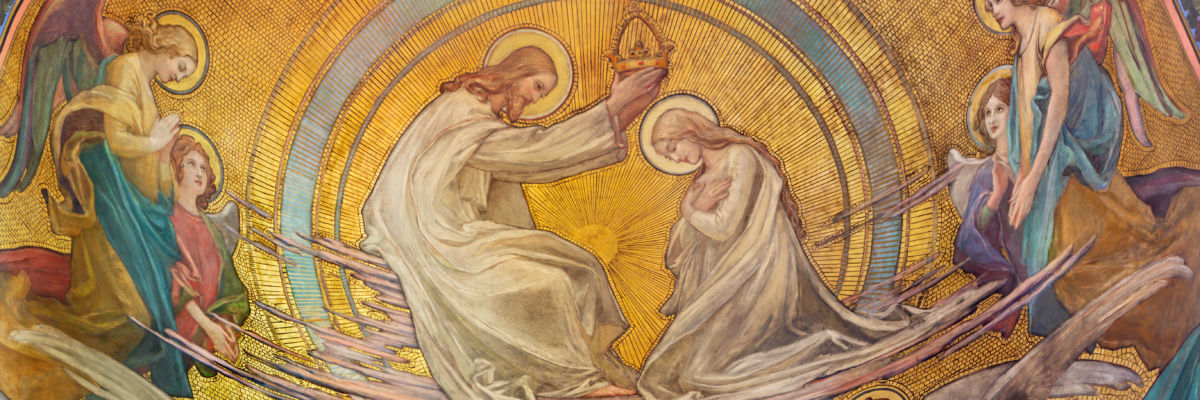
May 31 is a day when the feasts of the old liturgical calendar and the new liturgical calendar of the Catholic Church evoke a beautiful intersection of Marian feasts. On this day, the old calendar celebrates the Queenship of Mary, and the new calendar observes the Visitation. Considered together, these two commemorations present a comforting and glorious truth about the Blessed Virgin, capturing both queen and mother, the exaltedness and the closeness of Mary.
There is a remarkable and beautiful scene in the 1957 Swedish film The Seventh Seal, by Ingmar Bergman—an excellent film, absolutely worthy of Catholic attention. A member of a traveling troupe of clowns wakes up early in the morning, tumbles out of his covered wagon stretching, and suddenly has a vision. In a field by the forest, he sees the crowned Virgin Queen holding the hands of the Divine Child as she teaches him to walk. She looks up at the little juggler over the toddling Lord and returns his smile before disappearing. The clown rejoices at this queenly visitation, while giving the distinct impression that it was not the first time he had had the pleasure of unexpectedly coming upon holy Mary.
This moment captures something so central to the divine motherhood of Our Lady, who is mighty yet meek, high yet humble, bringing great grace for the salvation of all her children but maintaining the gentle touch of maternal care. Mary is the queen of heaven and earth, crowned with glory, but that does not mean she brings Our Lord to us with the pomp and clamor of some thunderous, terrible being. She comes quietly and smilingly to us through the gates of our hearts, bringing the Savior with her, just as she did to her cousin that day, long ago, when Elizabeth was visited by the queen, the mother of her Lord.
The famous words of Mary Immaculate at the Visitation are reflective of this paradox of the handmaid of the Lord and the queen of Heaven:
My soul doth magnify the Lord,
and my spirit hath rejoiced in God my Savior.
For he hath regarded the lowliness of his handmaiden.
For behold, from henceforth, all generations shall call me blessed.
For he that is mighty hath magnified me and holy is his Name.
The Church has always turned around the harmonious union of typically disparate realities, and the queenship of a houseguest is a wonderful instance of this. But unlike the high becoming low, as God became man in the Incarnation, we have in Mary the low becoming high, making her the perfect advocate and protectress for all of us.
The Marian mysteries hailed by both the traditional and modern Church calendars are, together, expressive of this wonderful dual nature of the humble queen, the gentle Mother of God, whose majesty is enshrined forever in heaven but who is still a mother we might all love as she loves us, who speaks, sings, visits her friends and family, and ponders things in her heart. Mary is the Theotokos, the “God Bearer,” which is a miracle of splendor, but she still is the careful and attentive woman who looks after those who need a helping hand. She is crowned by God, but she still smiles as she teaches God how to walk. She who helped Christ is now the help of Christians.
Besides the regal and congenial image in The Seventh Seal, another wonderful portrayal of Mary holding both the awesome power of queenship and the familiarity of a visitor is in G.K. Chesterton’s poetic masterpiece, “The Ballad of the White Horse,” when the Blessed Virgin appears, according to folklore, to the ancient British king, Alfred, after his defeat by the invading Danes. The words Chesterton gives the queen are strikingly comforting and down to earth, considering that they come from one who presides over the kingdom of Heaven:
The gates of heaven are lightly locked,
We do not guard our gain,
The heaviest hind may easily
Come silently and suddenly
Upon me in a lane.And any little maid that walks
In good thoughts apart,
May break the guard of the Three Kings
And see the dear and dreadful things
I hid within my heart.
Here again we find the tremendous truth about the majestic tenderness of Mary, who can be stumbled upon and who will share all that she has with her children, as any mother will. The twin observation on May 31 echoes this mystery beautifully, making it right and just to hail Mary, on this day, as her month closes out, as the mightiest of queens and the mildest of mothers. We, too, are visited by Mary and can visit her ourselves, whose queenship is eternal. And we can rejoice in her presence and her provisions as we would with both a monarch and a mother.
Those with particular dedication to the old calendar may see in this transition from the queenship to the visitation a liturgical movement toward familiarity that makes them favor the traditional formality of a more traditional Church. And it is true that much of what was austere or ceremonial about the rhythms of the liturgical year assumed a more free and personal aspect after the Second Vatican Council. But no good Catholic would deny—no matter what the state or style of the Church—that Mary is our mother and our queen, and as such, she deserves and inspires both our loyalty as subjects and our affection as children. Mary poses a challenge to all Catholics to find the often difficult Catholic balance between being servants and being friends with the divine hierarchy and the holy family.
Mary, blessed among women, brings Christ to mankind, and, as the smiling mediatrix who comes calling, holds a queenship within our hearts. These feast days both contrast and complement each other, for as the Visitation led to the Coronation, so did the celebration of the queenship of Mary cause Catholics to watch and wish for her visitations and, hence, signal the celebration of the Visitation.
We pray to the queen of Heaven on this last day of the month dedicated to her honor, as spring warms and wakens the earth with new life. Our Lady brought new life to earth by her “fiat,” and from that sprang the chance for eternal life. Let us join in praise to God through Mary as we sing her “magnificat,” with souls that magnify the Lord, just as she does who visits those who love her Son, and who holds the awesome power to raise us up to be happy with him forever.



